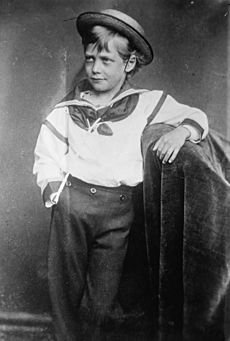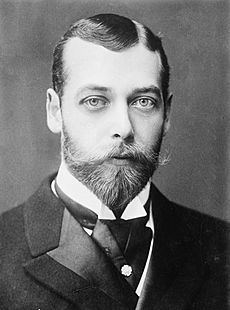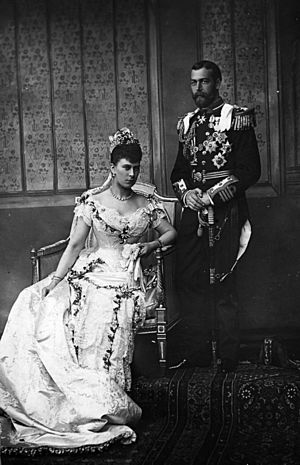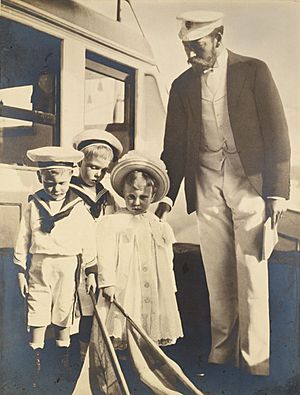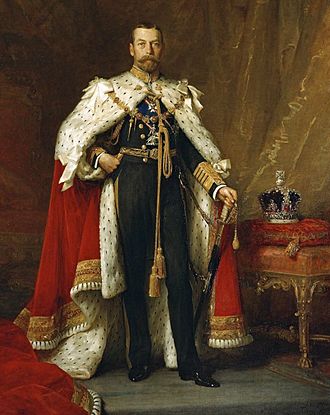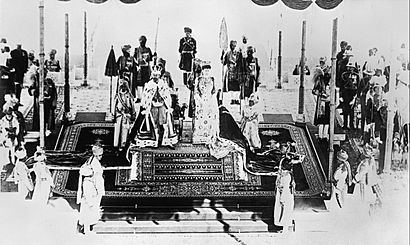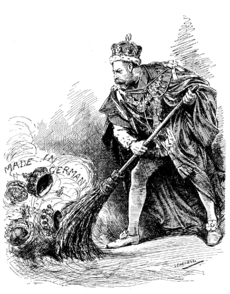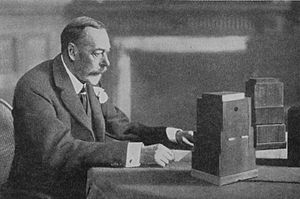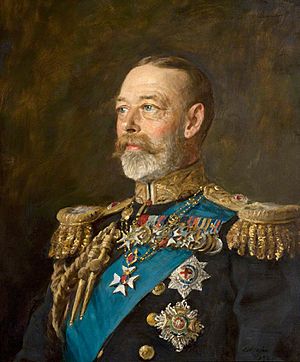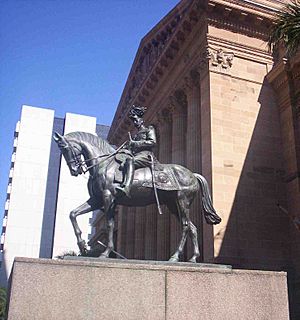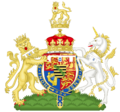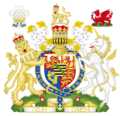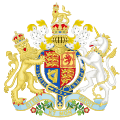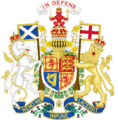George V facts for kids
Quick facts for kids George V |
|||||
|---|---|---|---|---|---|
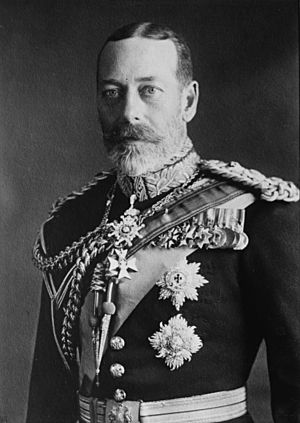
George V in 1923
|
|||||
| King of the United Kingdom and the British Dominions, Emperor of India |
|||||
| Reign | 6 May 1910 – 20 January 1936 | ||||
| Coronation | 22 June 1911 | ||||
| Imperial Durbar | 12 December 1911 | ||||
| Predecessor | Edward VII | ||||
| Successor | Edward VIII | ||||
| Born | Prince George of Wales 3 June 1865 Marlborough House, Westminster, Middlesex, England |
||||
| Died | 20 January 1936 (aged 70) Sandringham House, Norfolk, England |
||||
| Burial | 28 January 1936 Royal Vault, St George's Chapel, Windsor Castle
27 February 1939North Nave Aisle, St George's Chapel
|
||||
| Spouse | |||||
| Issue Detail |
|||||
|
|||||
| House |
|
||||
| Father | Edward VII | ||||
| Mother | Alexandra of Denmark | ||||
| Religion | Protestant | ||||
| Signature | |||||
| Military career | |||||
| Service | Royal Navy | ||||
| Years of active service | 1877–1892 | ||||
| Rank | See list | ||||
| Commands held |
|
||||
George V (George Frederick Ernest Albert; 3 June 1865 – 20 January 1936) was King of the United Kingdom and the British Dominions. He was also the Emperor of India. He ruled from 6 May 1910 until his death in 1936.
George was born when his grandmother, Queen Victoria, was on the throne. He was the second son of Albert Edward, Prince of Wales. This meant he was third in line to the throne. His father and older brother, Prince Albert Victor, were ahead of him. From 1877 to 1892, George served in the Royal Navy. His life changed when his older brother died unexpectedly in 1892. This put George directly in line to become king.
The next year, George married his brother's fiancée, Princess Victoria Mary of Teck. They had six children together. When Queen Victoria died in 1901, George's father became King Edward VII. George then became Prince of Wales. He became king himself when his father died in 1910.
George's time as king saw many big changes. New political ideas like socialism and communism grew. The British Empire was also changing. It reached its largest size in the early 1920s. The Parliament Act 1911 made the elected British House of Commons more powerful than the unelected House of Lords. During the First World War (1914–1918), the empires of his cousins, Nicholas II of Russia and Wilhelm II of Germany, fell apart. The British Empire, however, grew even larger. In 1917, George changed the royal family's name from the German-sounding House of Saxe-Coburg and Gotha to the House of Windsor. This was because people in Britain felt very anti-German during the war.
In 1924, he appointed the first Labour government. The Statute of Westminster 1931 recognized that the British Dominions were now separate, independent countries. They were part of the British Commonwealth of Nations. George had health problems later in his life. He died in January 1936. His oldest son, Edward VIII, became king. Edward gave up the throne later that year. His younger brother, Albert, then became King George VI.
Contents
Early Life and Education
George was born on 3 June 1865, in Marlborough House, London. His parents were Albert Edward, Prince of Wales, and Alexandra, Princess of Wales. His father was Queen Victoria's oldest son. His mother was the oldest daughter of King Christian IX of Denmark. George was baptized at Windsor Castle on 7 July 1865.
Since George was a younger son, no one expected him to become king. He was third in line to the throne. His father and older brother, Prince Albert Victor, were ahead of him. George was only 17 months younger than Albert Victor. The two brothers were educated together. Their tutor, John Neale Dalton, started teaching them in 1871. Neither brother was a great student. Their father believed the navy was "the very best possible training for any boy." So, in September 1877, when George was 12, both brothers joined the cadet training ship HMS Britannia.
From 1879, the princes served on HMS Bacchante for three years. Dalton went with them. They traveled to many parts of the British Empire. These included the Caribbean, South Africa, and Australia. They also visited Norfolk, Virginia, South America, the Mediterranean, Egypt, and East Asia. In 1881, they visited Japan. George got a blue and red dragon tattooed on his arm there. They also met Emperor Meiji. George and his brother gave Empress Haruko two wallabies from Australia.
After they returned to Britain, Queen Victoria was unhappy. Her grandsons could not speak French or German. So, they spent six months in Lausanne trying to learn another language. This was not very successful. After Lausanne, the brothers went their separate ways. Albert Victor went to Trinity College, Cambridge. George stayed in the Royal Navy. He traveled the world and visited many parts of the British Empire. He commanded Torpedo Boat 79 and later HMS Thrush. His last active service was on HMS Melampus from 1891 to 1892. After that, his naval rank was mostly honorary.
Marriage and Family Life
As a young naval officer, Prince George spent many years in Malta. He served under his uncle, Prince Alfred, Duke of Edinburgh. There, he fell in love with his cousin, Princess Marie of Edinburgh. His grandmother, father, and uncle approved of the match. However, his mother and Marie's mother did not. Marie's mother disliked England. Marie refused George's proposal. She later married Ferdinand, who became the King of Romania.
In November 1891, George's older brother, Albert Victor, got engaged. He was to marry Princess Victoria Mary of Teck, known as "May." Her parents were Francis, Duke of Teck and Princess Mary Adelaide of Cambridge.
On 14 January 1892, Albert Victor died from pneumonia. This happened six weeks after his engagement. George was now second in line to the throne. He was likely to become king after his father. George had just recovered from a serious illness himself. He had been sick with typhoid fever. Queen Victoria still thought Princess May was a good match for her grandson. George and May became close during their time of shared sadness.
A year after Albert Victor's death, George proposed to May. She accepted. They married on 6 July 1893 at the Chapel Royal in St James's Palace, London. They remained very devoted to each other throughout their lives. George found it hard to express his feelings in words. But they often wrote loving letters to each other.
Duke of York and Prince of Wales
His brother's death meant George's naval career ended. He was now second in line to the throne. Queen Victoria made George the Duke of York on 24 May 1892. He also started learning about constitutional history.
The Duke and Duchess of York had five sons and one daughter. Some people said George was a strict father. His children seemed to feel his strictness. His son Prince Henry later called him a "terrible father." However, George's parenting style was likely common for the time.
They mostly lived at York Cottage in Sandringham, Norfolk. This was a smaller house. Their life there was more like a comfortable middle-class family. George preferred a quiet life. This was very different from his father's busy social life. George loved stamp collecting. He helped build the Royal Philatelic Collection. It became one of the best collections of stamps in the world.
In October 1894, George's uncle-in-law, Alexander III of Russia, died. George went to Saint Petersburg for the funeral. A week later, he attended the wedding of the new Russian emperor, Nicholas II. Nicholas was George's cousin. He married Princess Alix of Hesse.
When Queen Victoria died on 22 January 1901, George's father became King Edward VII. George then became the Duke of Cornwall. Later that year, on 9 November 1901, he was made Prince of Wales. King Edward wanted to prepare George for his future role as king. George was given access to many state documents. He also allowed his wife, May, to see his papers. He valued her advice, and she often helped him write his speeches. As Prince of Wales, he supported changes in naval training.
From November 1905 to March 1906, George and May toured British India. George was upset by the unfair treatment of Indian people. He pushed for Indians to have a bigger role in their country's government. After this tour, they went to Spain for a royal wedding. Then they traveled to Norway for the coronation of King Haakon VII, who was George's cousin and brother-in-law.
Becoming King and Major Events
On 6 May 1910, Edward VII died. George then became king. George did not like his wife signing official papers as "Victoria Mary." He wanted her to use only one name. They decided she should not be called Queen Victoria. So, she became Queen Mary.
George did not like the anti-Catholic words in the Accession Declaration. This was a statement he had to make when opening his first parliament. He said he would not open parliament unless the words were changed. Because of this, the Accession Declaration Act 1910 was passed. It made the declaration shorter and removed the offensive parts.
George and Mary's coronation was held at Westminster Abbey on 22 June 1911. In July, they visited Ireland and received a warm welcome. Later in 1911, the King and Queen traveled to India for the Delhi Durbar. There, they were presented as the Emperor and Empress of India on 12 December 1911. George wore the new Imperial Crown of India. He announced that the capital of India would move from Calcutta to Delhi. He was the only Emperor of India to attend his own Delhi Durbar.
While traveling in India, George enjoyed hunting big game in Nepal. He was a very skilled shooter. On one occasion, he shot over a thousand pheasants in six hours. Even George admitted that "we went a little too far" that day.
Changes in British Politics
George became king during a difficult political time. The House of Lords had rejected the government's budget. This was unusual. Prime Minister H. H. Asquith wanted the previous king to create more Liberal peers. This would force the budget through the Lords. Edward had agreed, but only if the Lords rejected it after two elections.
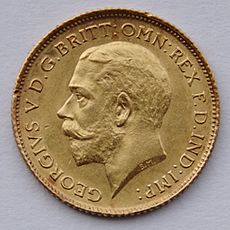
Asquith tried to reduce the power of the Lords. The Lords blocked his reforms again. George reluctantly agreed to create more peers if needed. After another election, the Lords allowed the bill to pass. The Parliament Act 1911 then removed most of the Lords' power to stop bills.
The elections in 1910 meant the Liberals needed support from the Irish Nationalist Party. Asquith introduced a law to give Ireland Home Rule. But the Conservatives opposed it. To avoid civil war in Ireland, George called a meeting at Buckingham Palace in July 1914. The meeting ended without an agreement. Soon after, events in Europe led to war. The issue of Irish Home Rule was put on hold.
The First World War
On 4 August 1914, Britain declared war on Germany. George wrote in his diary, "It is a terrible catastrophe but it is not our fault." From 1914 to 1918, Britain and its allies fought the Central Powers, led by Germany. The German Kaiser Wilhelm II was George's first cousin. Many of George's relatives had German titles.
On 17 July 1917, George changed the name of the British royal house. It went from the German-sounding House of Saxe-Coburg and Gotha to the House of Windsor. He and his British relatives gave up their German titles. They took on British-sounding last names. George gave his male relatives British noble titles instead.
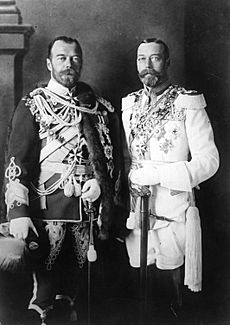
When Tsar Nicholas II of Russia, George's cousin, was overthrown in 1917, the British government offered him safety. However, George felt that having the Russian royal family in Britain might cause problems. So, the plan to rescue them was not carried out. The Tsar and his family were later killed in Russia. George was very saddened by this.
Two months after the war ended, George's youngest son, John, died at age 13. He had been ill his whole life. Queen Mary wrote that John had been "a great anxiety to us for many years."
In May 1922, the King visited Belgium and northern France. He saw the war cemeteries and memorials. This trip, and a short visit to Italy in 1923, were the only times George left the UK for official business after the war.
After the War
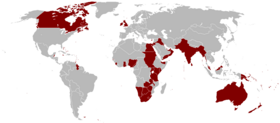
Before the First World War, many European countries were ruled by monarchs related to George. But after the war, many of these monarchies fell. George helped some of his relatives find safety.
In Ireland, Nationalists fought for independence. George was horrified by the violence. He called for peace. In 1921, he gave a speech asking for agreement. A truce was made a few weeks later. This led to the Anglo-Irish Treaty. By the end of 1922, Ireland was divided. The Irish Free State was formed.
George and his advisors were worried about the rise of socialism. George decided to be more open and connect with ordinary people. He became friendly with moderate Labour Party politicians. During the General Strike of 1926, George advised the government not to be too harsh. He said, "Try living on their wages before you judge them." This new approach made the royal family more popular.
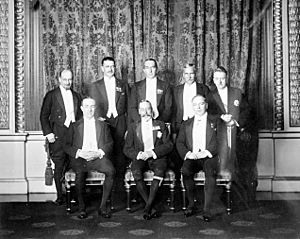
In 1926, George hosted a meeting called the Imperial Conference. Here, it was agreed that the British Dominions were self-governing. They were "equal in status" within the British Empire. The Statute of Westminster 1931 made this official. It also said that the succession to the throne could only be changed if all the Dominions' parliaments agreed.
During a world financial crisis in 1931, George encouraged a National Government to form. He even offered to reduce his own income to help the country's budget. He was concerned about the rise of Adolf Hitler and the Nazi Party in Germany. In 1934, he told the German ambassador that Germany was a danger to the world. He warned that war was likely within ten years if Germany continued its path.
In 1932, George agreed to give a Royal Christmas speech on the radio. This became a yearly tradition. He was not keen on it at first. But he was convinced that his people wanted to hear from him. By his Silver Jubilee in 1935, he was a very loved king. He said, "I cannot understand it, after all I am only a very ordinary sort of fellow."
George's relationship with his oldest son, Edward, became difficult. George was disappointed that Edward did not settle down. He was also upset by Edward's relationships. In contrast, he was fond of his second son, Prince Albert (later George VI). He also loved his oldest granddaughter, Princess Elizabeth. He called her "Lilibet," and she called him "Grandpa England." In 1935, George said about Edward: "After I am dead, the boy will ruin himself within 12 months." He hoped that nothing would stop Albert and Elizabeth from inheriting the throne.
Declining Health and Death
The First World War affected George's health. He was injured in 1915 when his horse threw him. He also had ongoing breathing problems. In 1925, his doctors sent him on a cruise to help him recover. This was his last trip abroad. In November 1928, he became very ill. For the next two years, his son Edward took over many of his duties. George never fully recovered.
In his last year, he sometimes needed oxygen. The death of his favorite sister, Victoria, in December 1935 made him very sad. On 15 January 1936, the King went to his bedroom at Sandringham House. He complained of a cold. He stayed in his room until he died. He grew weaker and drifted in and out of consciousness.
By 20 January, he was close to death. His doctors announced that "The King's life is moving peacefully towards its close." He died at 11:55 pm. The next day, his death was announced. He was described as "for each one of us, more than a King, a father of a great family."
At the procession for George's lying in state in Westminster Hall, a cross fell off his crown. It landed in the gutter. The new king, Edward, saw it fall. He wondered if it was a bad sign for his reign. As a sign of respect, George's four surviving sons stood guard by his coffin. This was called the Vigil of the Princes. It was not done again until the death of George's daughter-in-law, Queen Elizabeth The Queen Mother, in 2002. George V was buried at St George's Chapel, Windsor Castle, on 28 January 1936. Edward gave up the throne later that year. Albert then became King George VI.
Legacy and Impact
George V did not like posing for portraits. He also disliked modern art. He was so unhappy with one portrait that he ordered it to be burned. He did admire sculptors like Bertram Mackennal and William Reid Dick. Dick created the statue of George V outside Westminster Abbey in London.
Although he and his wife sometimes toured the British Empire, George preferred to stay home. He enjoyed stamp collecting and game shooting. His life was seen as quite ordinary. He was not an intellectual. He once wrote after an opera, "Went to Covent Garden and saw Fidelio and damned dull it was." But he was very dedicated to Britain and its Empire. He said, "it has always been my dream to identify myself with the great idea of Empire." He was seen as hardworking and was widely admired. Historian David Cannadine described King George V and Queen Mary as a "devoted couple" who valued "character" and "family values."
George set a standard for British royalty. It reflected the values of the middle class, not the upper class. He handled many difficult situations well. These included problems in Ireland, the First World War, and the first socialist government in Britain. He was a traditional person. He did not fully appreciate the big changes happening in British society. However, he always used his influence to be fair and calm. He saw his role as a mediator, not the final decision-maker.
Issue
| Name | Birth | Death | Marriage | Their children | ||
|---|---|---|---|---|---|---|
| Date | Spouse | |||||
| Edward VIII (later Duke of Windsor) |
23 June 1894 | 28 May 1972 (aged 77) | 3 June 1937 | Wallis Simpson | None | |
| George VI | 14 December 1895 | 6 February 1952 (aged 56) | 26 April 1923 | Lady Elizabeth Bowes-Lyon | Elizabeth II | |
| Princess Margaret, Countess of Snowdon | ||||||
| Mary, Princess Royal | 25 April 1897 | 28 March 1965 (aged 67) | 28 February 1922 | Henry Lascelles, 6th Earl of Harewood | George Lascelles, 7th Earl of Harewood | |
| The Hon. Gerard Lascelles | ||||||
| Prince Henry, Duke of Gloucester | 31 March 1900 | 10 June 1974 (aged 74) | 6 November 1935 | Lady Alice Montagu Douglas Scott | Prince William of Gloucester | |
| Prince Richard, Duke of Gloucester | ||||||
| Prince George, Duke of Kent | 20 December 1902 | 25 August 1942 (aged 39) | 29 November 1934 | Princess Marina of Greece and Denmark | Prince Edward, Duke of Kent | |
| Princess Alexandra, The Honourable Lady Ogilvy | ||||||
| Prince Michael of Kent | ||||||
| Prince John | 12 July 1905 | 18 January 1919 (aged 13) | None | None | ||
Images for kids
See also
 In Spanish: Jorge V del Reino Unido para niños
In Spanish: Jorge V del Reino Unido para niños
- Cultural depictions of George V
- Household of George V and Mary
- Interwar Britain
- List of covers of Time magazine (1920s), (1930s)


